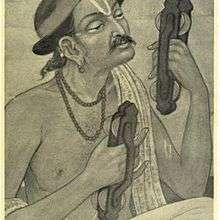Vaishnava Jana To
| "Vaishnava jana To" | |
|---|---|
| Song by Several artists like Lata Mangeshkar Jagjit Singh M. S. Subbulakshmi | |
| Published | 15th century |
| Genre | Bhajan, Devotional |
| Writer | Narsinh Mehta |
| Language | Old Gujarati |
Vaishnava Jana To is one of the most popular Hindu bhajans, written in the 15th century by the poet Narsinh Mehta in the Gujarati language. The bhajan was included in Mahatma Gandhi’s daily prayer. The bhajan speaks about the life, ideals and mentality of a Vaishnava Jana (meaning: a follower of Lord Vishnu).
Lyrics
Lyrics of the bhajan:

| Gujarati | Devanagari | Translation |
|---|---|---|
|
વૈષ્ણવ જન તો તેને કહિયે જે પીડ પરાયી જાણે રે |
वैष्णव जन तो तेने कहिये जे पीड परायी जाणे रे। |
Call those people as Vaishnavas (devotees of Lord Vishnu) who, |
|
સકળ લોકમાં સહુને વંદે, નિંદા ન કરે કેની રે |
सकळ लोकमां सहुने वंदे, निंदा न करे केनी रे। |
Vaishnavas, respect the entire world, |
|
સમદૃષ્ટિ ને તૃષ્ણા ત્યાગી પરસ્ત્રી જેને માત રે |
समदृष्टि ने तृष्णा त्यागी, परस्त्री जेने मात रे। |
Vaishnavas see all equally, renounce greed and avarice, |
|
મોહ માયા વ્યાપે નહિ જેને, દૃઢ વૈરાગ્ય જેના મનમાં રે |
मोह माया व्यापे नहि जेने, दृढ़ वैराग्य जेना मनमां रे। |
Vaishnavas do not succumb to worldly attachments, |
|
વણ લોભી ને કપટ રહિત છે, કામ ક્રોધ નિવાર્યાં રે |
वणलोभी ने कपटरहित छे, काम क्रोध निवार्या रे। |
Vaishnavas encompasses the absence of greed and deceit, |
Influence
This bhajan has inspired many people, and was one of the favourite bhajans of Mahatma Gandhi.[1]
In 1999, this song has been rendered in a single album by top artistes such as classical vocalists, Gangubai Hangal and Pandit Jasraj and pop star Remo Fernandes and also including, Sarod maestro Amjad Ali Khan, Pandit Narayan on the sarangi, flute maestro Hariprasad Chaurasia and santoor exponent Shivkumar Sharma played an instrumental rendition of this song.[2][3] Along with "Raghupati Raghava Raja Ram", the song is also sung regularly by Delhi's best known western classical choral groups — The Capital City Minstrels at its annual Peace Concerts coinciding with Gandhi Jayanti. Carnatic guitarist Baiju Dharmajan created an instrumental guitar version of the prayer in 2013.
In movies
Elements of the hymn were included in Hollywood film Gandhi (1982), in Bollywood films like Water (2005) & Road to Sangam (2009) and Kollywood film Hey Ram (2000). The hymn was also used as a title song for several Indian films. In Telugu movie Prathinidhi (2014), first stanza of this song is used during climax scene. In Malayalam movie Indian Rupee (2011), first stanza of this song is used in climax scene sung by Bombay Jayasree.Obviously, the song finds a place in the Gujarati biopic of the author called 'Kunvaar Bhainu Mameru'.
See also
References
- ↑ "Gandhi's Favourite Hymns".
- ↑ "Album on Gandhi’s hymn". Tribune. Retrieved 12 March 2012.
- ↑ Nalini Natarajan; Emmanuel Sampath Nelson (1996). Handbook of Twentieth-Century Literatures of India. Greenwood Publishing Group. pp. 100–. ISBN 978-0-313-28778-7. Retrieved 10 October 2012.